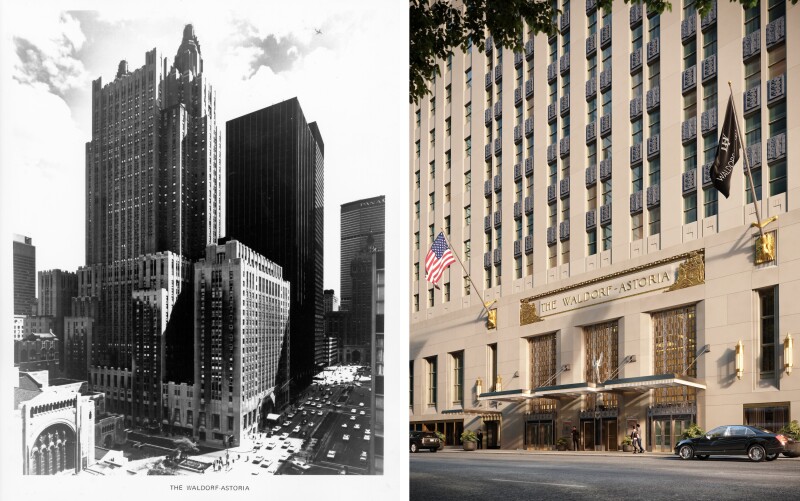Loyalty program: Hilton Honors
Rates: From $1,500
The Afar take—reviving a New York icon
After an eight-year closure and a multibillion-dollar restoration, the Waldorf Astoria is back on Park Avenue—and, at last, the legend matches the fantasy. For decades after the hotel’s 1931 debut, it was a living room for New Yorkers to see and be seen, and a place where celebrations happened—proposals, weddings, and glamorous galas with heads of state, royalty, and Hollywood A-listers in attendance.
In the Waldorf Astoria’s final years leading up to its 2017 closure, the sprawling, 1,400-room hotel still drew travelers with its name and legacy, but many left disappointed by ragged edges and faded glory. The reimagined art deco colossus overhauled the accommodations (now including residences too) and reduced the hotel room count to 375, allowing better attention to guests. Meanwhile, the public spaces—from the soaring Park Avenue lobby with its mosaic floors and murals to the chandeliered ballrooms—were all cleaned and repaired. During my recent stay following the July 2025 opening, the restoration work was so staggering that I half expected Cole Porter, who once lived in the hotel, to sit down again at his grand piano, which now anchors the reinvigorated Peacock Alley lounge.
I am not a neutral observer. I grew up in another of NYC’s grand dames, the Plaza Hotel, in the 1980s. Back then, it and the Waldorf still held some echo of the 1920s glamour that birthed them, even when buried by dust and age. Renovations of this kind of hotel can be tricky. I’ve seen what over-polish can do: The shine intensifies as the patina vanishes. But at the Waldorf, the renovation is just right. The magic of New York’s Gilded Age feels revived for a new generation at the Waldorf Astoria, whose renewed splendor feels like it opened yesterday—with world-class service to match.
It all started with a family feud

The Waldorf Astoria New York’s art deco facade dates to 1931.
Courtesy of Waldorf Astoria New York
The birth of the Waldorf began with a family feud that rippled through New York society. In 1893, William Waldorf Astor, driven by a rivalry with his aunt, Caroline Astor, demolished his father’s mansion on Fifth Avenue and built a stately hotel in its place, right next to Caroline’s home. Four years later, not to be outdone, his cousin John Jacob Astor IV (yes: the same Astor who met his end on the Titanic) answered by building the Astoria Hotel next door, and soon after, society promenaded between them in a marble corridor named Peacock Alley.
The two hotels became the living room for New York elites until 1929, when both were knocked down to make way for the Empire State Building. The hotel re-emerged as the Waldorf-Astoria in 1931 on Park Avenue; the name had been purchased by Lucius Boomer in 1929, and hiring architects Schultze & Weaver, he built the hotel in only two years. The design elements throughout the building still embody the glamour and optimism of 1930s New York, and few examples match the Waldorf Astoria’s scale, craftsmanship, and innovation of its time.
Over the decades, the Waldorf Astoria has hosted such U.S. presidents as Herbert Hoover, Harry Truman, and Dwight Eisenhower—some of whom lived there—and welcomed royals, including Queen Elizabeth II, Prince Rainier and Grace Kelly, and King Hussein of Jordan. Hollywood stars like Marilyn Monroe and Elizabeth Taylor called its suites home too. Historic moments abound, from Winston Churchill’s Cold War speeches to the Rock & Roll Hall of Fame ceremonies held in its opulent ballroom.
Who’s the Waldorf Astoria New York for?
When it comes to luxury hotels, visitors to New York are spoiled for choice. Few, however, feel as grand and embedded in New York City’s story as the Waldorf Astoria. Travelers dreaming of a celebratory trip will find this hotel is worth the splurge-y $1,500 starting rate for the privilege of calling it home for a few days. (Anytime I could tell someone I was staying at the Waldorf Astoria, I got a tiny thrill.) Locals looking to hold a big event, be it a wedding or a gala dinner (the Alfred E. Smith Memorial Foundation dinner, held here for decades, is back for its 80th anniversary), won’t be disappointed. Spa enthusiasts will be drawn to the 20,000-square-foot Guerlain spa, which opens later this fall.
The location: Park Avenue
Taking up an entire city block on East 49th and 50th streets between Park and Lexington avenues in Midtown, the Waldorf Astoria is well located near Grand Central Terminal, a major subway hub and another exalted example of New York’s architectural heritage. The hotel is within walking distance of Rockefeller Center, the high-street shops of Fifth Avenue, and the Museum of Modern Art. On weekdays, the area is humming with people and cars, though it tends to empty out on nights and weekends. The neighborhood, with its gleaming skyscrapers, is less of a fit for those who want to be in NYC’s more atmospheric neighborhoods; if you want smaller-scale charm, café culture, and a nightlife scene, look below 23rd Street.
After an eight-year closure and a multibillion-dollar restoration, the Waldorf Astoria is back on Park Avenue—and, at last, the legend matches the fantasy.
The rooms at the Waldorf Astoria New York

A junior suite at the Waldorf Astoria New York
Courtesy of Waldorf Astoria New York
French designer Pierre-Yves Rochon turned the accommodations—once filled with blocky furniture and gloomy corners—into sanctuaries with neutral palettes and subtle nods to art deco in curvy brass handles and table legs. Compared to the opulence of the art deco details downstairs, one might crave a notch or two more of color and texture, but I appreciated my room’s residential feeling: Its cozy alcoves with books and large-format paintings provided a calming effect between jaunts into the frenetic city.
Many layouts now start at a sprawling 570 square feet, more than double the original room sizes in some cases. Automated drapery replaces heavy curtains, and bathrooms are spa-like, thanks to deep soaking tubs, separate showers, and oversize marble vanities. My enormous bed had a stay-in-all-day quality, and I found that the double-glazed windows of my ninth-floor room overlooking Park Avenue reduced street noise to a low hum.
The food and drink

A Steinway piano played by Cole Porter when he lived at the hotel is a centerpiece at the iconic Peacock Alley bar, now open for food and drink service.
Photo by Alex Lau
The culinary experiences at the Waldorf Astoria tap both history and contemporary New York dining culture. They include the Peacock Alley lounge, American brasserie-style Lex Yard, and Japanese-Western restaurant Yoshoku.
At Peacock Alley, guests gather in lounge chairs around the four-faced walnut and bronze Victorian clock—a centerpiece gifted to the hotel by Queen Victoria—and live music fills the air most nights. When I was there, performers in sequined gowns swished by, adding to the theatrical atmosphere. The cocktail program is by Jeff Bell, who launched New York’s speakeasy and spirit-cocktail revival when he opened PDT in the East Village in 2007. Here at the Waldorf, his playful, balanced drinks match the vibe; my refreshing Lombardo Spritz cocktail had grapefruit, koval rose hip liqueur, and prosecco. The acoustics were designed to bounce sound across the room to energize the space, creating a lively hub, though my companions preferred the quiet environment of Lex Yard, where they could talk more easily.
By contrast, Lex Yard on the Lexington Avenue side offers a subdued vibe across its two-story, brasserie-inspired dining room with curvaceous booths by New York–based interior design firm AvroKo. Led by chef Michael Anthony of Gramercy Tavern fame, the kitchen reflects his signature approach to seasonality. We started with oysters and chef Anthony’s remix on the iconic Waldorf salad invented at the hotel, which replaces the traditional mayonnaise dressing with a bright citrus-honey vinaigrette—I’ve read mixed reviews, but I’m on Team Waldorf Salad 2.0. We ordered the prix fixe menu and enjoyed Long Island royal red shrimp in chive oil and an expertly prepared black bass in yogurt sauce, both ideal for the humid late-summer evening. The prix fixe portions were a bit too generous with our extra starters, so if you go for that, come with an appetite or go light on additions.
I was most pleasantly surprised by Yoshoku restaurant, which launched quietly in lounge-style alcoves tucked on either side of the Park Avenue side entrance. While the ambience still needs to evolve with better lighting and music (I hear that’s in the works), the restaurant, helmed by chef Ry Nitzkowiski, who worked at two more of NYC’s hit and hip dining spots Zero Bond and Momofuku Noodle Bar, offers an alluring menu that ranges from nigiri and sashimi to mains like a succulent quail katsu topped with a sweet-tart tonkatsu sauce. My dining companion and I especially loved the eel donburi, with rice intentionally left crispy at the bottom of the bowl.
Staff and service

The Silver Corridor at the Waldorf Astoria New York was inspired by the Hall of Mirrors in Versailles.
Photo by Alex Lau
As soon as I stepped out of my yellow cab at the hotel’s Park Avenue entrance to check in, Elvis, a front desk ambassador, was waiting for me. By the time I’d finished, my bag was already upstairs; minutes later he appeared in the hall and offered to walk me through the room’s features. “This is the most exciting job I’ve ever had,” he told me between dropping bits of Waldorf lore as we went.
Being part of the reopening of the Waldorf Astoria was clearly a source of pride for staff, and that augmented my stay at every turn. Meanwhile, the smaller number of rooms concentrated attention in a way that allows the staff to better serve and connect with guests—and handle more than one role when necessary. Even when pressing “0” to move a Peacock Alley reservation or to request a late checkout, I wasn’t transferred elsewhere; anyone who answered the line resolved my requests in seconds.
This focus on empowering staff continues in the back of the house. They have what one employee described to me as a “green room”: a large lounge area with mirror-lit stations, an array of Guerlain makeup shades, grooming products, and a full-time on-site tailor keeping uniforms (designed by British couturier Nicholas Oakwell’s NO Uniform studio) impeccable. The result shows on the floor, with employees like Elvis who look stage-ready and act like they have the authority to make your day easier.
Accessibility
The hotel has step-free arrival via the 49th-Street porte cochere with valet/drop-off. Public spaces include nine ADA lifts, and there are 32 ADA-designated guest rooms in the hotel. Accessible room types include Mobility Accessible configurations with roll-in showers, and accessible tubs (hearing-accessible variants are also offered). Event venues are also ADA accessible.
Afar was a guest of the Waldorf Astoria New York. Our coverage is independent; the hotel did not review or approve this story.








